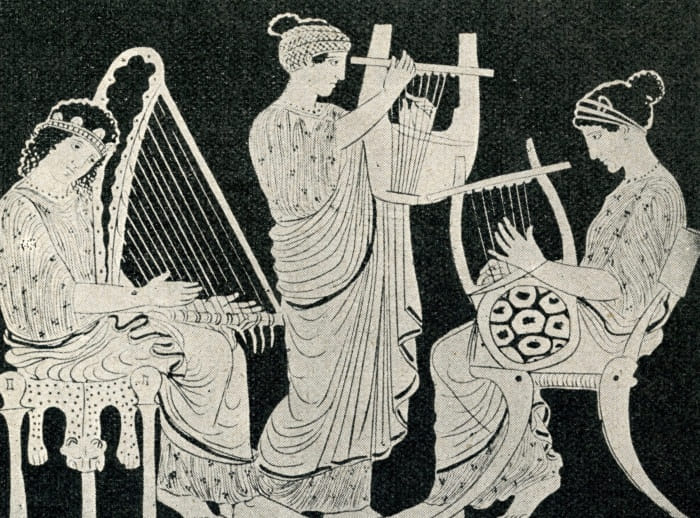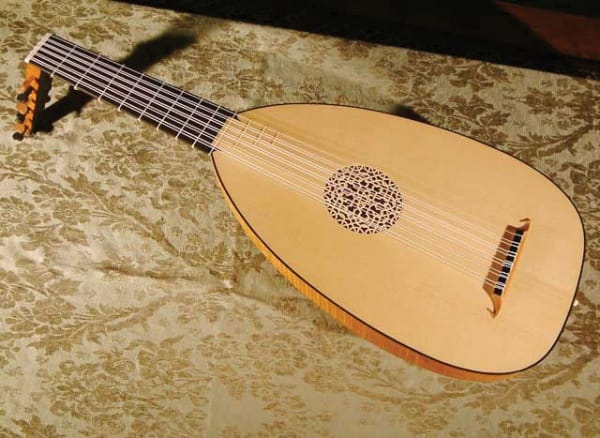In ancient times, lyre and lute could be found in a whole host of musical events around Europe. People who played them and performed for the aristocracy would make a lucrative career, indeed.
However, many are confused between these two instruments these days because of their similar names and explanations.
This article will provide you with more comprehensive details and insights into lyre and lute.
Lyre vs Lute: Difference Between Them?
Lyre
The lyre is a musical instrument originating in the Balkan nations - Greek nowadays - from 1400 BC. It is exceptionally notable when referring to illustrations of Greek mythology.
Although Greek mythology isn't a real story, it's a part of Greek culture and has become famous around the globe.
The image of goddesses playing their lyre by the stream or in heaven has been admired for generations. Its design resembles a little harp but is associated with apparent variations.
The lyre could be a sort of instrument in which the strings are connected to a yoke. It is in the same plane with the resonator and consists of two arms and a crossbar.

Music researchers generally believe the lyre to be a branch of the zither family. This family included several alternative stringed instruments, like the lute, guitar, kantele, and psalm.
However, there also are alternative views, considering lyre and zither as 2 separate categories.
Experts assert that the zither is distinguished by the strings that stretch across all or most of its body, or the highest surface of the body, conjointly referred to as the resonator.
Meanwhile, the lyre has strings that originate from an extension pipe. Other instruments in the same family are piano (a sort of zither but with keys) and a bowed stringed instrument (known as a finger lyre).
Some specialists have even argued that instruments, just like the bowed stringed instrument and stringed instrument, are considered unique from the harp. As a result, they do not have strings or risers to mount resonators as "real" lyres do.
Lute
The lute is also a stringed instrument but features a round and hollow form with holes on its body. The lute string square is parallel to the surface, and that they build the sound.
However, the lute isn't only regarded as an instrument name. In fact, it can refer to all instruments that have the same structure.
They belong to the family of lutes, originating from Europe, within the Hornbostel - Sachs system.

The strings are connected to a peg or post at the tip of the neck. There are a variety of knobs for players to regulate the strings.
They can become tighter or looser depending on different pitches to fit a music piece or singer’s voice.
Particularly, the player uses one hand to pluck the string close to the body, whereas the opposite hand presses the string at the neck.
By doing this, they can raise or lower the peak of the rope to form different chords and harmonies.
Last update on 2024-04-25 at 22:32 UTC - 4/ Affiliate links / Images from Amazon Product Advertising API
The History Of Lyre And Lute
Both lyre and lute descended from a standard European antecedent but have been used for different purposes and events.
The lyre was contended by the traditional Greeks and might be the most vital and notable instrument device in the ancient world. In Greek mythology, the lyre is employed in varied stories.
Apollo was the best lyre-player god who educated another god, Orpheus, how to play this instrument. Yet, the invention of the seven-stringed version of the lyre is attributed to the Terpander of Lesbos.
The lute was utilized in big events from the late Baroque period, and it was considered one of the most influential musical instruments throughout the Renaissance.
Within the era of Baroque music, lutes were used as the instruments that contend the accompaniment, typically incidental vocal compositions.
Thanks to its beautiful tone, many people have fallen in love with lutes. Several lute players were notable throughout Europe, well-known for traveling everywhere to perform for the most lavish royal palaces.
Lyre vs Lute: Which Sounds Better?
Both lyre and lute produce soft, clear sound, which is appropriate for various musical genres. Check out this video if you want to listen to music played with lyres:
The lyre is a stringed instrument that is ideal for playing the scale or gapped scale. It's sort of a harp with a delicate and quiet sound, which makes people confused when trying to tell them apart.
Lyre players will accompany jury-rigged singing exploitation chords. They also support the obtainable bass or play a pre-written accompaniment within the score.
The lyre’s sound creates a comparatively quiet and soothing atmosphere. Additionally, the shape of the lyre is appropriate for events that perform ancient and fairy-style music.
Unlike lyre, the lute’s sound creates a sense of joy, freshness, and excitement. It is suitable for royal and luxury performances.

Is It Hard To Play Lyre And Lute?
The lyre is harder to play when compared to the lute.
Specifically, playing lyre requires 3 common techniques - also known as block-and-strum techniques.
They have been portrayed in a wide range of classical and medieval works or inferred in prehistoric sculptures.
About the first technique, the player’s dominant hand is employed to strum the strings, while the other hand is holding up the lyre by strings.
Therefore, he/she can hold the strings directly in-tuned with the fingers, which primarily turns it into a lyre form.

Referring to the second technique, the unblocked strings depend on which kind of chords you're using. With seven strings tuned diatonically, you'll be able to play chords altogether.
Alternatively, you'll be able to pluck it with one hand at lyre vogue and one hand behind. This conjointly provides access to pinch harmonics, enabling you to play both the primary harmonic and the second harmonic.
Lute is easier to play, which is quite the same as a classical guitar. The differences are its lighter string tension. The lute tuning is usually G, C, f, a, d, g, equivalent to E, A, d, f#, b, e.
Conclusion
The lyre and lute are known for their origin from Europe, representing ancient musical culture and renaissance.
Despite their different shapes and numbers of strings, they both produce a soothing and pleasant sound.
I hope that our article has helped you with some valuable insights and knowledge about lyre vs lute as well as their distinctive features.
Related Posts:
Banjo vs Ukulele: The Differences You Need To Know
Mandolin Vs Banjo Comparison: Which Is Easier?







Thank you that was very helpful. I would have liked to hear what a lute sounds like to compare the two.